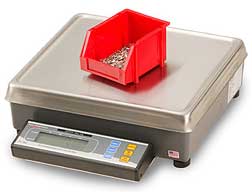 Counting scales are versatile tools that offer manufacturers, companies, and businesses large and small solutions to common challenges posed by ensuring the inventory of small parts, components, and pieces is accurate. Maintaining and managing an accurate inventory of these items is essential to that company’s success. In general, a lack of inventory for a business increases the risk of losing sales, while too much inventory can tie up vital working capital. Without a balanced inventory of parts and components on hand, a manufacturer not only loses production but cannot make delivery of products on time. Knowing what inventory is on hand and monitoring the pace at which it moves allows companies to project their needs and control operations costs accurately. Maintaining an accurate inventory is the means to successfully manage the supply chain that is the company’s backbone.
Counting scales are versatile tools that offer manufacturers, companies, and businesses large and small solutions to common challenges posed by ensuring the inventory of small parts, components, and pieces is accurate. Maintaining and managing an accurate inventory of these items is essential to that company’s success. In general, a lack of inventory for a business increases the risk of losing sales, while too much inventory can tie up vital working capital. Without a balanced inventory of parts and components on hand, a manufacturer not only loses production but cannot make delivery of products on time. Knowing what inventory is on hand and monitoring the pace at which it moves allows companies to project their needs and control operations costs accurately. Maintaining an accurate inventory is the means to successfully manage the supply chain that is the company’s backbone.
Counting Inventory Manually vs. Counting Scales
Counting and tracking inventory then is vital to a company’s success. Without counting scales, keeping track of inventory requires setting aside a few days each month to count stock manually. Manually counting inventory is a long, tedious process that often redistributes employee productivity or requires farming out the task to a third party. Either way is costly. Physically counting parts or pieces, especially large quantities of smaller items is an inefficient use of time. Still, the boredom inherent in the process is prone to human error resulting in miscounting.
Counting scales reduce manual counting by converting weight information into count information. In industrial settings, counting scales provide an effective method to count large quantities of small parts in less time more efficiently. Scales are manufactured in a variety of designs and sizes for use on a warehouse floor, a workbench, or desktop. They are well-suited for inventory control in such environments as warehouses, factories, production facilities, quality control centers, and shipping and receiving.
Counting scales work by counting and weighing objects simultaneously. They can measure large batches of units based on the entry of a sample weight from a single unit or, for increased accuracy, several units. The scale then calculates the number of units by dividing the total weight by the sample unit’s weight (s). The accuracy and integrity of the count are determined first by the readability of the scale, i.e., the lowest reading of the lightest part. Before purchase, consider that a scale with a readability set to 0.1g cannot read the weight of a part that weighs 0.05g. Secondly, a scale’s internal resolution also plays a role in determining its accuracy. Internal resolution is the scale’s ability to convert the signals from a weighted mass into a digital output on the display. Scales that have very high internal resolutions are very accurate.
Counting Scales are More Accurate and More Efficient
Because small differences in weight can influence the accuracy of the reading, and thus, the count, readability, and internal resolution are key terms to keep in mind when deciding which counting scale system would be suitable to meet company inventory control needs. Also important is the data transfer options of the counting scales. Several models enable the transfer of accurately weighed data from the scale to a company’s database for easy computer access and inventory control.
Data transfer is an efficient and optimal way to keep track of inventory. Options for transferring data vary—from a simple USB transfer and RS-232 serial transmission to Ethernet connections or WiFi. Data transfer is advantageous to retail stores and warehouses that sell or house large volumes of identical items. Manufacturers that produce large volumes of parts and components for industries also benefit from data transfer. Automotive, aerospace, durable goods, medical and healthcare, agriculture, IT, construction, and many more industries depend on an accurate inventory to supply the small parts, sensors, hardware, components, and so forth to maintain production.
Counting scales are exceptionally useful tools for maintaining inventories and reducing the time it takes to count identical items of the same material and weight accurately. Once a sample weight has been programmed into the scale, accurate counts can be derived from the weighing platform’s total mass. Counting scales are helpful in numerous industries for managing and monitoring inventories.
They can be used to check the number of items in a lot or create a lot to ensure the necessary material is always on hand. Counting scales are especially vital to those industries that make, sell, move or house small parts and pieces. Keeping an accurate tally of small parts by counting them manually is tedious, inefficient, and unlikely due to human error. Counting scale provides the most reliable and efficient method of counting and keeping track of large quantities of small parts in real-time, allowing companies to keep track of inventory and successfully manage their supply chains.



Leave a Reply